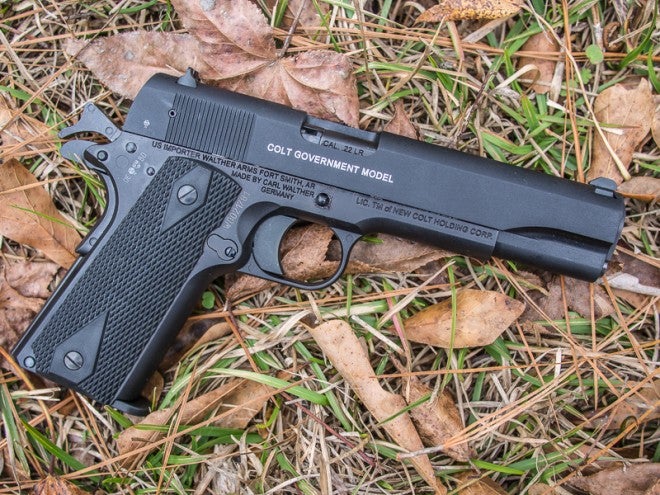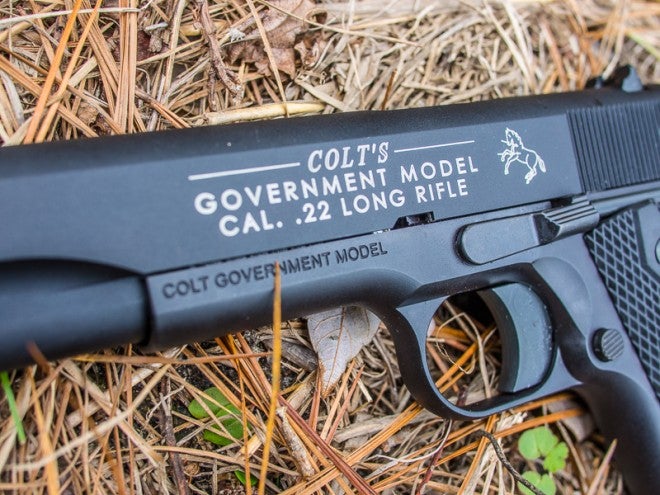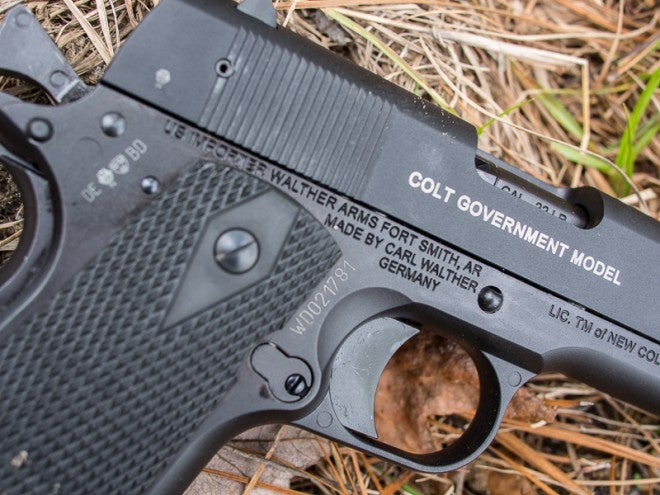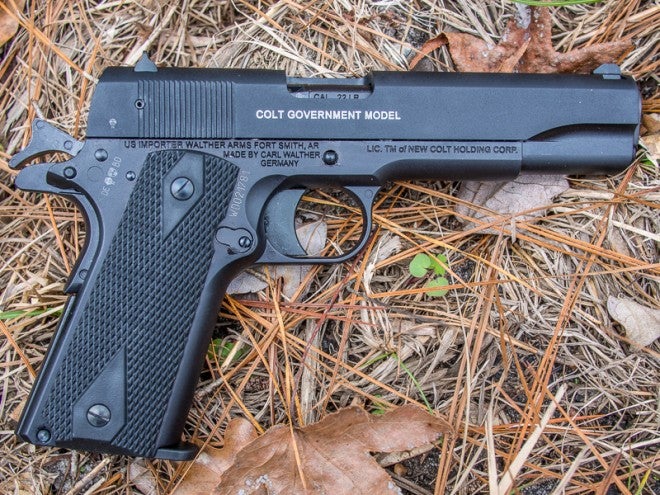Walther/Colt Government 1911A1 .22LR
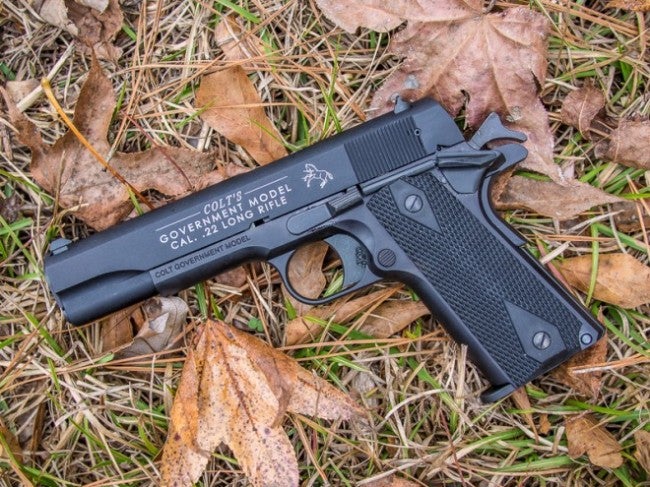
The 1911 needs no introduction. As the standard service pistol for the U.S. Armed Forces from 1911 to 1985, the 1911 served our country for a literal lifetime. This storied heritage of performance, in combination with the 1911′s ubiquity, translated to a steady and enthusiastic adoption in the civilian market. Without question, the M1911 .45ACP enjoys one of the most fervent fan bases in the civilian shooting world for a number of reasons. The ease of obtaining aftermarket parts, the typically crisp single-action trigger, and the patriotic symbolism of this old standard have made this one of the most popular guns on the market today.
VIDEO
Unfortunately, as many of our readers know, ammo prices have skyrocketed over recent history, with a sharp spike in the past couple of years in particular. Many of us may recall when brass cased .45ACP ammunition was $10-$15 for a box of fifty rounds. Now, if you can find it, brass .45ACP is closer to fifty cents a round. This means that those of us who own 1911s are in for at least fifty bucks every time we want to get some practice with our .45s.
While there’s nothing quite like practicing with the round that your 1911 was made for, a salvo of full size 1911s chambered in .22 have hit the market, offering the next best thing – a near identical manual of arms and trigger, even similar weight and dimensions, but designed to shoot the less expensive .22LR round, making practice cheaper and certainly less tiresome. Ignoring the fact that, lately, even .22LR has been difficult to find, it’s cheaper than .45ACP either way, and a .22LR 1911 would quickly pay for itself after only a few range visits.
Walther has been manufacturing a great example of this full-size .22 1911 under license from Colt, and we were sent the .22 1911A1 for review. As with the Walther PPK/S .22LR, this .22 is made in Germany by Walther, and as you will see from the review, this pistol feels and performs as you would expect a German-made handgun to perform.
Walther claims that this is the It is the “only genuine Colt tactical rimfire replica available in the world” and that it was designed and manufactured according to the original Colt plans and at a 1:1 scale, which makes this gun very appealing to own if you already have a stable of 1911s.
Specifications:
The Colt/Walther Government 1911A1 is chambered in .22LR with a magazine capacity of 12 rounds. It weighs 2.25 pounds empty, and it has an aluminum slide and a zinc alloy frame. OAL is 8.6 inches with a 5-inch barrel. It is blowback operated with a single-action trigger that Walther pegs at 5.5 pounds, although it felt a bit heavier when shooting a new gun. The rear sight is drift-adjustable, as is the removable front sight. Like the standard 1911, the Walther/Colt has manual thumb and grip safeties.
As stated, the Walther/Colt .22LR is on a 1:1 scale with the standard 1911, and accepts many regular 1911 accessories.
One bonus offered by this .22 replica is the M8x.75mm threaded barrel. While this barrel has a flush muzzle (the barrel does not extend past the slide), the muzzle end of this gun has a thread protector that can be twisted off to expose muzzle threads. This allows the user to attach a muzzle device such as a thread adapter, allowing you to attach a silencer if you elect. This feature is in common with the Walther P22 and Walther PPK/S .22LR. Since I imagine this can’t be a cheap addition, the fact that Walther has opted to include this while maintaining a reasonable asking price is a surprising yet very welcome modification. Fellow shooters/silencer owners know how costly it can be to get a threaded barrel for a pistol, so this is a windfall to those of us with rimfire suppressors, and I applaud Walther for applying this trait across the board with its reciprocating-slide .22s.
Street price at time of writing seems to hover around $400.
General Observations:
Similar to the Walther PPK/S .22LR we recently reviewed, this is a handsome pistol with excellent fit and finish. The finish is a flat black that seems durable enough, and looks good if you like the retro/parkerized GI 1911 look. As mentioned earlier, Walther claims that they relied upon Colt drawings and plans to make this gun, and it shows. Without picking it up, this .22 looks like the real deal from a foot away, and it is the same size as the standard 1911. Similar to the PPK/S .22LR, but unlike other modern reciprocating-slide .22s, this pistol handles and feels like an actual handgun and not just a cheap, plastic-y range toy.
And how does it fare on the range?
Again, similar to the PPK/S .22LR, function was 100% with bulk pack .22LR and CCI Stinger. Over two range sessions and five hundred rounds with no cleaning or lubrication whatsoever, there were no malfunctions, which is the exception, rather than the rule, with reciprocating-slide .22LRs like this. I should also mention that approximately two hundred rounds were also fired with a suppressor, which typically will increase the accumulation of fouling in the gun. Note that the standard 1911 sights this comes equipped with will likely be tall enough to be usable with a .22 suppressor if you do mount one. And as I was fresh off of the PPK/S review, I made sure to keep my support thumbs away from the slide – since these reciprocating-slide .22s create only enough energy to cycle the slide, any additional friction such as a thumb riding the slide may cause the 1911 .22 to fail to lock into battery.
Walther claims this is a 5.5lb trigger. While I did not measure the trigger weight, this sounds about right, although the pull on my test gun may have been a touch heavier – break-in would probably bring it into 5.5lbs if it isn’t already. That said, the trigger has a short travel period and a nice, crisp break – just like grandad’s 1911 – which translates into good accuracy. While all shooting was informal and no bench or rested groups were taken, this is as accurate as any other stock .22 pistol you have shot, if not more so. Three inch freehand groups at ten yards were easy to make.
Disassembly is similar in some respects to a standard 1911. First, one removes the magazine and disengages the safety. Second, the recoil spring plug at the muzzle must be depressed and the bushing rotated. Once these pieces are removed, the recoil spring slides out easily.
After that point, disassembly is similar to the other Walther .22s – The slide is pulled back to lock, and the slide release can be pushed out of the frame. Once you’ve done this, the slide can be pulled back and off the rails of the frame, then pushed forward to clear the slide from the barrel.
Negative Observations:
Again, like the Walther PPK/S .22LR, my chief complaint is the inclusion of only one magazine, with replacements costing $35. This is not an inordinate sum, but it adds 10% to the cost of the gun if you want two magazines. Also, it is a bit of an inconvenience that the barrel is fixed and pinned in place, therefore not replaceable by the average shooter.
Other than that, there is almost nothing to improve upon with this “little” 1911. While some shooters may complain about the use of zinc alloy in the frames, Walther has stated that this is a sophisticated zinc alloy that they selected for its durability, and therefore, they do not anticipate any issues with the frames as a result. I do not see this as an issue with this otherwise-robust .22LR.
Conclusion:
After reviewing this gun and the Walther PPK/S .22LR, it looks like Walther’s German-made rimfire pistols are coming in hot. Both of them performed flawlessly with no cleaning or lubrication out of the box and over hundreds of rounds, and both are accurate guns. Both replicate very successfully their namesakes – this 1911 feels like, well, a 1911. Not only does this gun perform well, but it looks good, and it emulates well the look and feel of a 1911.
In addition to the aforementioned reliability, Walther hit this one out of the park in employing several nuanced features that should not be overlooked and that set this .22 apart from its competition: First, it is a 1:1 scale, true size replica of the 1911. I would think regular 1911 shooters would relish the opportunity to use a full-size replica of their chief sidearm or favorite tournament gun, but chambered for the much-less-expensive .22 caliber. Second, and tangentially related, this 1911 is licensed by Colt and designed using Colt shop plans and drawings. That also means that many, many 1911 accessories will be compatible with this plinker. Third, anyone who shoots with a suppressor will realize what a blessing it is to receive a pistol with factory threads. If you own or plan to own a silencer, factor in the couple hundred it would cost to outfit a pistol with a threaded barrel, and you will see why Walther’s decision to thread these barrels was a good one.
In conclusion, Walther’s collaboration with Colt bears fruit in this 1911 replica – a reliable and handsome full-size replica of the traditional 1911 that pays the homage this venerable design is due.

